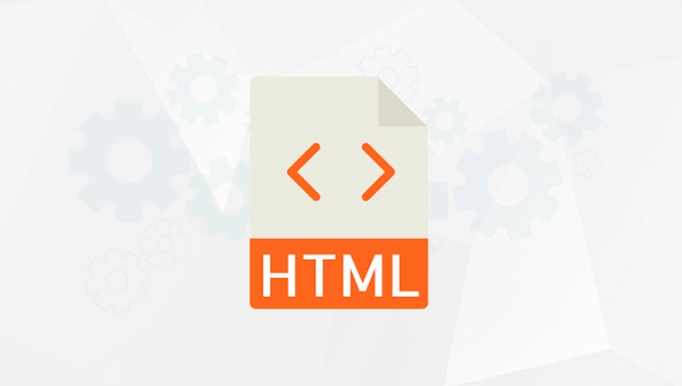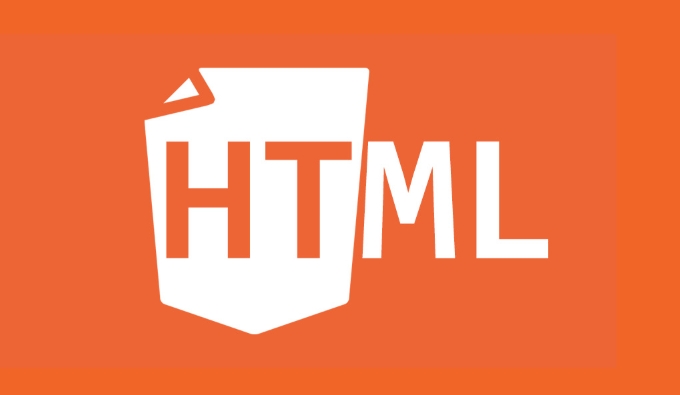HTML `canvas` for Dynamic Graphics and Animations
Jul 21, 2025 am 02:53 AMCanvas is HTML5's drawing API suitable for dynamic graphics and animations. 1. It is based on pixel operation and is efficient and suitable for games and visualization; 2. When using it, you need to first obtain the context to draw graphics, such as drawing rectangles, circles, etc.; 3. Animation is achieved by clearing the canvas, updating the status, and redrawing, and using requestAnimationFrame to control the frame rate; 4. Performance optimization includes reducing the redraw area, avoiding frequent creation of objects, and using off-screen canvas; 5. Interaction is achieved by listening to events and coordinate calculations, such as click detection. Mastering these key points allows you to create smooth and efficient animations.

Canvas is a very practical drawing API provided by HTML5, which is especially suitable for dynamic graphics and animations. It is not based on DOM like SVG, but operates pixels directly on the canvas, which is efficient and is suitable for scenes such as games, data visualization, real-time animation, etc.

Basic usage: try drawing a graphic first
The first step in using canvas is to get the context and draw the content through this context. The most common one is the 2D rendering context.
<canvas id="myCanvas" width="400" height="300"></canvas> <script> const canvas = document.getElementById('myCanvas'); const ctx = canvas.getContext('2d'); ctx.fillStyle = 'red'; ctx.fillRect(50, 50, 100, 100); </script>
The above code is to draw a red rectangle on the canvas. It looks simple, but that's the basis for all complex graphics. You can draw lines, circles, text, pictures, and even path combinations.

One thing to note is that canvas is a "forget it after drawing" pattern, and there is no object model. Once you finish drawing a graphic, it blends with the background, unless you record the state yourself and re-draw it.
Principle of animation implementation: Continuously repaint the picture
The essence of canvas animation is to continuously clear the canvas, update the status, and re-draw. Usually we use requestAnimationFrame to drive the animation loop.

For example, make a simple moving ball:
let x = 0;
function animate() {
ctx.clearRect(0, 0, canvas.width, canvas.height); // Clear canvas ctx.beginPath();
ctx.arc(x, 150, 20, 0, Math.PI * 2);
ctx.fillStyle = 'blue';
ctx.fill();
x = 2;
if (x > canvas.width) x = 0;
requestAnimationFrame(animate);
}
animate();This example is simple, but it shows the basic structure of the animation:
- Clear the canvas
- Update location or status
- Repaint
- Call yourself to continue with the next frame
This allows for smooth animation effects.
Performance optimization: Don't let animations get stuck
Canvas animations can easily affect performance if they are not handled properly, especially in complex scenarios. Here are some common suggestions:
- Reduce redrawing area : If you only change a part, you can just clear that piece, not the entire canvas.
- Avoid frequent creation of objects : for example, do not create new paths or style objects in each frame, and prepare in advance.
- Use off-screen canvas reasonably : draw static content on a hidden canvas first, and then copy it to the main canvas to improve efficiency.
- Control frame rate : Not all animations require 60 frames per second, and proper throttling can save resources.
For example: If you want to draw many fixed background elements, you can first draw them on an off-screen canvas when initializing, and then just draw it as an image to the main canvas.
Interactive support: Click and drag can be done
Although canvas itself does not support event binding, you can interact by listening to the mouse or touching events and combining coordinate judgment.
For example, to detect whether a circular area has been clicked:
canvas.addEventListener('click', function(e) {
const rect = canvas.getBoundingClientRect();
const mouseX = e.clientX - rect.left;
const mouseY = e.clientY - rect.top;
const dx = mouseX - x;
const dy = mouseY - y;
const distance = Math.sqrt(dx*dx dy*dy);
if (distance < radius) {
console.log('Clicked!');
}
});This idea can also be extended to more complex interactions such as buttons, drag and drop, and zoom.
Basically that's it. Canvas is not particularly difficult, but to create smooth and efficient animations, you still need to pay more attention to details, especially performance and structural design.
The above is the detailed content of HTML `canvas` for Dynamic Graphics and Animations. For more information, please follow other related articles on the PHP Chinese website!

Hot AI Tools

Undress AI Tool
Undress images for free

Undresser.AI Undress
AI-powered app for creating realistic nude photos

AI Clothes Remover
Online AI tool for removing clothes from photos.

Clothoff.io
AI clothes remover

Video Face Swap
Swap faces in any video effortlessly with our completely free AI face swap tool!

Hot Article

Hot Tools

Notepad++7.3.1
Easy-to-use and free code editor

SublimeText3 Chinese version
Chinese version, very easy to use

Zend Studio 13.0.1
Powerful PHP integrated development environment

Dreamweaver CS6
Visual web development tools

SublimeText3 Mac version
God-level code editing software (SublimeText3)
 Applying Semantic Structure with article, section, and aside in HTML
Jul 05, 2025 am 02:03 AM
Applying Semantic Structure with article, section, and aside in HTML
Jul 05, 2025 am 02:03 AM
The rational use of semantic tags in HTML can improve page structure clarity, accessibility and SEO effects. 1. Used for independent content blocks, such as blog posts or comments, it must be self-contained; 2. Used for classification related content, usually including titles, and is suitable for different modules of the page; 3. Used for auxiliary information related to the main content but not core, such as sidebar recommendations or author profiles. In actual development, labels should be combined and other, avoid excessive nesting, keep the structure simple, and verify the rationality of the structure through developer tools.
 Implementing Clickable Buttons Using the HTML button Element
Jul 07, 2025 am 02:31 AM
Implementing Clickable Buttons Using the HTML button Element
Jul 07, 2025 am 02:31 AM
To use HTML button elements to achieve clickable buttons, you must first master its basic usage and common precautions. 1. Create buttons with tags and define behaviors through type attributes (such as button, submit, reset), which is submitted by default; 2. Add interactive functions through JavaScript, which can be written inline or bind event listeners through ID to improve maintenance; 3. Use CSS to customize styles, including background color, border, rounded corners and hover/active status effects to enhance user experience; 4. Pay attention to common problems: make sure that the disabled attribute is not enabled, JS events are correctly bound, layout occlusion, and use the help of developer tools to troubleshoot exceptions. Master this
 Configuring Document Metadata Within the HTML head Element
Jul 09, 2025 am 02:30 AM
Configuring Document Metadata Within the HTML head Element
Jul 09, 2025 am 02:30 AM
Metadata in HTMLhead is crucial for SEO, social sharing, and browser behavior. 1. Set the page title and description, use and keep it concise and unique; 2. Add OpenGraph and Twitter card information to optimize social sharing effects, pay attention to the image size and use debugging tools to test; 3. Define the character set and viewport settings to ensure multi-language support is adapted to the mobile terminal; 4. Optional tags such as author copyright, robots control and canonical prevent duplicate content should also be configured reasonably.
 Best HTML tutorial for beginners in 2025
Jul 08, 2025 am 12:25 AM
Best HTML tutorial for beginners in 2025
Jul 08, 2025 am 12:25 AM
TolearnHTMLin2025,chooseatutorialthatbalanceshands-onpracticewithmodernstandardsandintegratesCSSandJavaScriptbasics.1.Prioritizehands-onlearningwithstep-by-stepprojectslikebuildingapersonalprofileorbloglayout.2.EnsureitcoversmodernHTMLelementssuchas,
 HTML for email templates tutorial
Jul 10, 2025 pm 02:01 PM
HTML for email templates tutorial
Jul 10, 2025 pm 02:01 PM
How to make HTML mail templates with good compatibility? First, you need to build a structure with tables to avoid using div flex or grid layout; secondly, all styles must be inlined and cannot rely on external CSS; then the picture should be added with alt description and use a public URL, and the buttons should be simulated with a table or td with background color; finally, you must test and adjust the details on multiple clients.
 How to associate captions with images or media using the html figure and figcaption elements?
Jul 07, 2025 am 02:30 AM
How to associate captions with images or media using the html figure and figcaption elements?
Jul 07, 2025 am 02:30 AM
Using HTML sums allows for intuitive and semantic clarity to add caption text to images or media. 1. Used to wrap independent media content, such as pictures, videos or code blocks; 2. It is placed as its explanatory text, and can be located above or below the media; 3. They not only improve the clarity of the page structure, but also enhance accessibility and SEO effect; 4. When using it, you should pay attention to avoid abuse, and apply to content that needs to be emphasized and accompanied by description, rather than ordinary decorative pictures; 5. The alt attribute that cannot be ignored, which is different from figcaption; 6. The figcaption is flexible and can be placed at the top or bottom of the figure as needed. Using these two tags correctly helps to build semantic and easy to understand web content.
 What are the most commonly used global attributes in html?
Jul 10, 2025 am 10:58 AM
What are the most commonly used global attributes in html?
Jul 10, 2025 am 10:58 AM
class, id, style, data-, and title are the most commonly used global attributes in HTML. class is used to specify one or more class names to facilitate style setting and JavaScript operations; id provides unique identifiers for elements, suitable for anchor jumps and JavaScript control; style allows for inline styles to be added, suitable for temporary debugging but not recommended for large-scale use; data-properties are used to store custom data, which is convenient for front-end and back-end interaction; title is used to add mouseover prompts, but its style and behavior are limited by the browser. Reasonable selection of these attributes can improve development efficiency and user experience.
 How to handle forms submission in HTML without a server?
Jul 09, 2025 am 01:14 AM
How to handle forms submission in HTML without a server?
Jul 09, 2025 am 01:14 AM
When there is no backend server, HTML form submission can still be processed through front-end technology or third-party services. Specific methods include: 1. Use JavaScript to intercept form submissions to achieve input verification and user feedback, but the data will not be persisted; 2. Use third-party serverless form services such as Formspree to collect data and provide email notification and redirection functions; 3. Use localStorage to store temporary client data, which is suitable for saving user preferences or managing single-page application status, but is not suitable for long-term storage of sensitive information.






